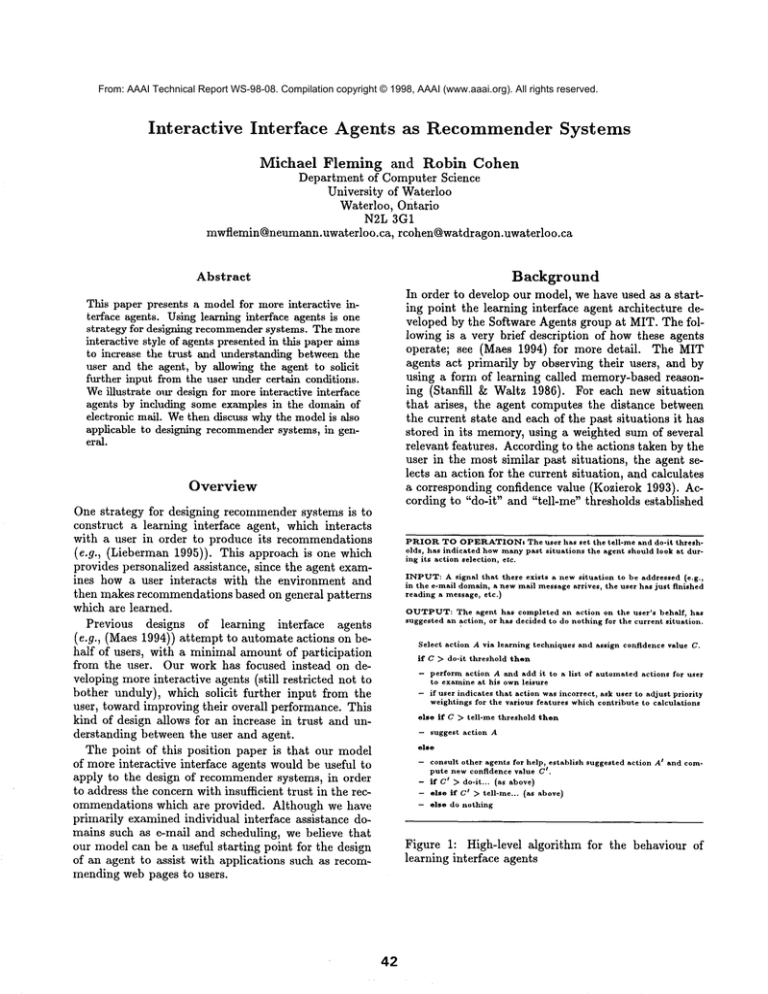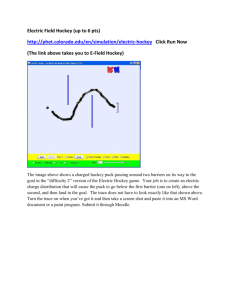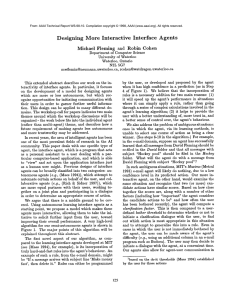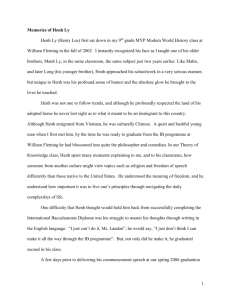
From: AAAI Technical Report WS-98-08. Compilation copyright © 1998, AAAI (www.aaai.org). All rights reserved.
Interactive
Interface
Michael
Agents
Fleming
as
Recommender
Systems
and Robin Cohen
Department of Computer Science
University of Waterloo
Waterloo, ontario
N2L 3G1
mwflemin@neumann.uwaterloo.ca, rcohen@watdragon.uwaterloo.ca
Background
Abstract
In order to develop our model, we have used as a starting point the learning interface agent architecture developed by the Software Agents group at MIT. The following is a very brief description of how these agents
operate; see (Maes 1994) for more detail. The MIT
agents act primarily by observing their users, and by
using a form of learning called memory-based reasoning (Stanfill ~ Waltz 1986). For each new situation
that arises, the agent computes the distance between
the current state and each of the past situations it has
stored in its memory,using a weighted sum of several
relevant features. According to the actions taken by the
user in the most similar past situations, the agent selects an action for the current situation, and calculates
a corresponding confidence value (Kozierok 1993). According to "do-it" and "tell-me" thresholds established
This paper presents a modelfor more interactive interface agents. Using learning interface agents is one
strategy for designing recommendersystems. The more
interactive style of agents presented in this paper aims
to increase the trust and understanding between the
user and the agent, by allowing the agent to solicit
further input from the user under certain conditions.
Weillustrate our design for moreinteractive interface
agents by including some examples in the domain of
electronic mail. Wethen discuss whythe modelis also
applicable to designing recommendersystems, in general.
Overview
One strategy for designing recommendersystems is to
construct a learning interface agent, which interacts
with a user in order to produce its recommendations
(e.g., (Lieberman 1995)). This approach is one which
provides personalized assistance, since the agent examines how a user interacts with the environment and
then makes recommendations based on general patterns
which are learned.
Previous designs of learning interface
agents
(e.g., (Maes 1994)) attempt to automate actions on
half of users, with a minimal amount of participation
from the user. Our work has focused instead on developing more interactive agents (still restricted not to
bother unduly), which solicit further input from the
user, toward improving their overall performance. This
kind of design allows for an increase in trust and understanding between the user and agent.
The point of this position paper is that our model
of more interactive interface agents would be useful to
apply to the design of recommendersystems, in order
to address the concern with insufficient trust in the recommendations which are provided. Although we have
primarily examinedindividual interface assistance domains such as e-mail and scheduling, we believe that
our model can be a useful starting point for the design
of an agent to assist with applications such as recommending web pages to users.
PRIOR TO OPERATIONs The user has set the tell-me and do-it thresholds, has indicatedhow many past situationsthe agent should look at during its actionselection,
etc.
INPUT: A signal that there exists
a new situation
to be addressed (e.g.,
in the e-mail domain, a new mall message arrives, the user has just finished
reading a message, etc.)
OUTPUT: The agent
suggested an action,
Select
action
has completed
or has decided
A via learning
techniques
and assign
confidence
value
C.
if
C ~> do-it
-
perform action A and add it to a list of automated actions
for user
to examine at his own leisure
if user indicates that action was incorrect, ask user to adjust priority
weightings for the various features which contribute to calculations
else
if
- suggest
threshold
an action
on the user’s
behalf,
has
to do nothing for the current situation.
C ~> ten-me
action
then
threshold
then
A
else
-- consult other agents for help, establish
t.
pute new confidence value C
- if Ct ~ do-it...
(as above)
- else if Ce ~> tell-me...
(as above)
- else do nothing
suggested
action
At and com-
Figure 1: High-level algorithm for the behaviour of
learning interface agents
42
with the goal of improving the agents’ overall performance. A very high level algorithm for our semiautonomous agents is shown in Figure 2. The major
points of this algorithmare explained in this paper, illustrated for the domainof assisting users with e-mail.
by the user, the agent determines whether to automate
an action on the user’s behalf, to suggest an action,
or to do nothing at all. Figure 1 shows a high-level
description of the behaviourof these learning agents.
More Interactive
Interface
Agents
Ambiguous situations
In our model, we address the problemof ambiguoussituations: ones in whichthe agent, via its learning methods, is unableto select one course of action as being a
clear winner. (See steps 6-10 in the algorithm.) For example, in the e-mail domain,suppose an agent has successfully learned that all messages from David Fleming
should be re-filed in the David folder and that all messages with subject "Hockeypool" should be filed in the
Hockey folder. Whatwill the agent do with a message
from David Fleming with subject "Hockeypool"?
Suppose a message with the following feature values
has just been read:
While the MITdesign has manystrong points, several
shortcomingscan be identified (Fleming 1998). In particular: (i) these agents do not deal very well with situations that are somewhatambiguous;(ii) the lack
communicationbetween agent and user makes it difficult for a user to understandandto trust such an agent;
(iii) memory-based
learning can be quite slow because
it mayrequire an examinationof a large numberof previous situations.
Weaddress these issues and others, by presenting
a variation on the architecture of the MITlearning
agents. This new model allows for agents which are
still moreor less autonomous,but which recognize opportunities for asking the user for further information,
PRIOR TO OPERATION: The user
has set
the
bother thresholds,
has indicated
how many past
should look at during its action selection,
etc.
tell-me,
situations
INPUT: A signal that there exists a new situation
in the e-mail domain: a new mail message arrives,
ished reading a message, etc.)
to be addressed (e.9.,
the user has just fin-
OUTPUT: The agent has completed an action
on the user’s
suggested an action or has communicated to the user that it
ing for the current situation.
do-it
the
(1)
Use learning
A1, ...,
Aa
(2)
if
choice
confidence
value
1993), for example)
actions
C (as
in
the
MIT agents
Feature
Value
Distance
-
,x(s..... ~,)
(4) if C do -it th reshold th
en pe rform ac tion A an d in dicate
that there is a proposed rule for the user to approve/reject/edit
(8)
(6)
else
if C > tell-me
else //choice
scores
unclear
threshold
because
action
two or more actions
From
0.90
David
else // choice still
Feature
Value
Distance
have similar
A(S.... ~2)
factor
advice
Feature
Value
Distance
Feature
Value
Distance
threshold
Action
scoring
difference
action
is considered
exceeds
threshold
the
(say,
clear
score
if
Subject
0.88
Date
October
0.92
INoneCC0 t
0.8892
under David
3
Habs
0.98
Subject
Hi
1
From
Owen Barnhill
1
Cc
None
0
I
[
File
Date
October 7
0.86
0.9086
under Hockey
Subject
Hockey pool
0
CF.
(10) if CF > user-defined
bother
then initiate
dialogue with user.
aThe choice
Date
0.01
File
unclear
Compute clarification
Subject
Hockey pool
26
None
October 11
0
0.90
0.8714
File under David
From
David Fleming
0
Action
(9)
Date
October
IO°
IOteIubJct
Fleming
0
Action
A
and are able to provide trustworthy
recommended action
[
Cc
0.08
Action
(7) if peer agents exist
then automate/suggest
(8)
then suggest
Cc
None
Finally, suppose that the following four messages
were found to be the most similar to the current situation, with the distance betweenthe value in the current
situation and the correspondingvalue in the past situation shownin the third row. The overall distance between two situations (shown in the fourth row) is computed by taking the sum of the products diw~, where
di is the distance betweenthe values of field i andw~ is
the weight assigned to field i.
A is clear a then
of action
(3) Compute
see (Kozierok
to get possible
Feature
Well/he
behalf,
has
can do noth-
Consult rule database for applicable rules previously created by the
user (with or without the agent’s help). If a single rule is found
apply, then use that rule. If two or more conflicting
rules are found,
initiate rule conflict dialogue with user. If no rules are found to apply, then proceed with step 1.
From
David
Flemin~
Supposealso that the agent has assigned the following weights to each of the relevant fields, based on how
well the current situation’s value in each of those fields
has typically predicted the action taken (as in (Kozierok
1993)).
and
agent
(0)
techniques
Feature
Value
S. Fillmore
1
None
0
File
October 23
0.90
0.9090
under Hockey
Subject
Hockey pool
0
the score computed for the highest-
of the next
best
choice
In such a situation, MIT’sMaxims(Metral 1993)
mail agent would compute scores for each of the two
candidate actions (File under David and File under
Hockey), would choose the action with the higher score
and wouldcalculate a confidence value. In this case, the
by a constant
10~).
Figure 2: High-level algorithm for our moreinteractive
interface agents
43
scores for the two actions wouldbe very close together;
the agent would choose to file the message in the David
folder but would have a very low confidence value. As
a result, this agent would likely do nothing in such a
situation. It would be the responsibility of the user to
realize that nothing had been done, and to perform an
appropriate action himself.
Our more interactive agent, on the other hand, would
examine the same situation and recognize that two candidate actions have similar scores. Based on howclose
together the scores are, along with a number of other
factors, 1 the agent will computea clarification factor.
This clarification factor is then compared to a userdefined bother threshold to determine whether or not to
initiate a clarification dialogue with the user. The goM
of such a dialogue is to find out which action is most
appropriate in this situation and to attempt to generalize this into a rule. An example screen is presented
below:
Situation:
The following
From
I David Flemin~
Possible
message
Oc
None
has just
Possible
[]
]
Subject
Hockey pool
File
Action
under David
under
Hockey
Please click on the action
this interaction.
Score
2.272
2.201
I------"~7
or elicklCancellto
Prom*
David Fleming
Subject,
Hockey pool ]
Prom,
*
rules,
Actiont
i
I
--+ Hockey [
ACCEPT
I
Action:
ALL RULES
~
--+ Hockey ]
]
"question box" where it would store information about
situations with which it could benefit from the user’s
help, but for which it chose not to interrupt the user
immediatelydue to a low clarification factor. This question box would appear in the interface as a small box
in the lower left corner of the screen, indicating how
manyquestions the agent currently had. The user could
choose to click on this box at his own convenience, in
order to initiate dialogues of the form presented earlier.
iii
Explanation
In past situations
in
which the sender was
David Fleming, the action
taken was File under David
in 95% of cases.
In past situations
in
which the subject was
"Hockey pool",
the action
taken was File under Hocl~ey
in 100~ of cases.
you wish to choose,
]
Figure 3: Agent’s proposal of possible rules
actions:
File
Hockey pool
REJECT
been read
Date
Oct. 27
Subjectt
Rule base
Another novel aspect of our algorithm, as compared
to the learning interface agents developed at MIT, is
its incorporation of truly hard-and-fast rules into the
agent’s behaviour. An example of such a rule, from
the e-mail domain, might be "If a message arrives with
subject line ’Makemoneyfast’, then delete it." Rules
can either be programmed by the user, or developed
and proposed by the agent when it has high confidence
in a prediction (as in Step 4 of Figure 2). Althoughthe
MITgroup does provide "rules" for its agents, these
rules are simply represented as hypothetical situations,
and are treated just as though they were situations the
agent had actually observed in the past. In any new
situation, an agent would still have to examine each
past situation in its memoryand go through a series of
calculations. Our proposal is for the agent to maintain
an entirely separate database of rules, which can be
fired immediately whenever an appropriate situation is
encountered.
Webelieve that the incorporation of rules is a necessary addition for two main reasons: (1) it will likely
speed up the agent’s performance2 in situations where
it can simply apply a rule, rather than going through
a series of complexcalculations involved in the agent’s
learning algorithm; (2) because rules are more explicit
and concrete than the calculations involved in learning techniques, having a separate rule base which is
conclude
If the user were to choose the action File under
Hockey, for example, the agent would proceed to propose two rules, as seen in Figure 3. The first states
specifically that whenthe subject line is "Hockeypool"
and the message sender is David Fleming, the message
should be filed in the Hockeyfolder. The second rule is
more general, and states that any messages with subject
line "Hockeypool", regardless of the sender, should be
filed in the Hockeyfolder. The user has the option of accepting or editing either of these rules, or of cancelling
the interaction entirely if neither rule is appropriate.
Even in cases in which the user is not immediately
bothered by the agent (i.e., the clarification factor does
not exceed the bother threshold), the agent can indicate
that it has a question for the user without actuMly requiring the user to deMwith it immediately. To achieve
this interaction, we propose having the agent maintain a
1These factors include how"important" the agent considers the candidateactions to be (based on the do-it thresholds (Maes1994) established by the user for those actions)
and howoften the user has been bothered recently. Weomit
the presentation of the actual formulain this short paper.
2Note that, in practice, the actual gain in performance
by using a nile-based approach would depend strongly on
the size of the nile base and on the format used to represent
rules,
44
user share responsibilities quite well, and should always
be aware of whois responsible for what tasks. Uponencountering any new situation, it is understood that the
agent will attempt to do whatever it can to perform an
action for the user (or to make a suggestion) using the
knowledgeit has previously acquired. If it has insufficient information to do anything, it will still be able
to inform the user by adding messages to the question
box discussed earlier. 3 The design decisions made for
interface agents may be useful to motivate the design
of other kinds of mixed-initiative systems.
always available to inspect would help to provide the
user with a better understanding of, more trust in, and
a better sense of control over, the agent’s behaviour.
Our agents also allow for agent-user communication in
the event of conflicts occurring in the actual rules programmedby the user (Step 0). This communication
not through natural language, but rather via dialogue
boxes, menusand buttons in a graphical user interface.
(Fleming 1998) presents examples illustrating dialogues
to address such rule conflicts.
Self-monitoring
and explanations
We also provide means by which agents can monitor
their own performance, by comparing their predictions
to the actions actually taken by the user, and can propose appropriate times for thresholds to be manipulated. This would reduce the amount of work the user
has to do, in terms of watching the agent, determining
how well it is performing, and deciding when to give
the agent more or less autonomy.
Furthermore, we propose a more general technique
for providing users with explanations of agent actions.
Rather than simply referring the user to situations from
the past which are considered similar to the current
situation, the agent should be able to generalize what
it has seen, in order to present it to the user in an
English sentence. Details of each of these mechanisms
can be found in (Fleming 1998).
Recommender
Systems
The goal of interface agents is to help the user deal with
a particular computer-basedapplication, and to off-load
some of the tedious or repetitive work. Our work looks
at the degree to which such systems communicate with
a human user. There is a definite tradeoff involved
here: both the agent and user can benefit a great deal
from increased interaction;
however, an agent which
constantly interrupts with questions and explanations
is bound to become an annoyance. The model which
we propose aims to provide improved performance over
strictly learning interface agents, allowing users to be
more aware (and trusting) of their agents’ activities,
while keeping the bother level to a minimum.
The algorithm we have proposed identifies some general opportunities for initiating clarification dialogues
with users, providing a mechanism for agents to interact with users, without bothering them excessively.
The particular decisions which we have made, with regard to specific details such as the exact form of agentuser communication and some of the formulas proposed
in (Fleming 1998), are certainly flexible, and would depend strongly on the application area. The algorithm
we present can be used as a starting point for any researcher wishing to develop a more interactive type of
interface agent, because it identifies opportunities for
both the agent and the user to initiate further communication. (Fleming 1998) also provides a generalized
description of the algorithm, which does not rely on
the underlying learning techniques from the MITagent
designs.
With a clear algorithm for interacting with users
when there is ambiguity, making users aware of what an
agent is contemplating and allowing users to take the
initiative to direct an agent, we feel that we have provided a good framework for assistance in recommender
system environments, where there is indeed some uncertainty and a clear role for users to maketheir preferences known. Because recommender systems attempt
to make recommendations to their users, they can indeed be modelled as personal assistants. The tradeoff
Reflecting
on Initiative
Our work also has something to offer to the growing
mixed-initiative research area ((Allen 1994), (Burstein
& McDermott 1996)). Several important issues have
been identified, which must be addressed when designing mixed-initiative systems, including:
¯ specification of when exactly the system and user
should communicate, and what that communication
should look like;
¯ registration of context whenone party interrupts the
other;
¯ ensuring that both parties share the responsibilities
involved in the task, and are fully aware of the responsibilities of each party.
For the particular application of interface agent design, our model addresses each of these issues.
An algorithm is presented for determining when an
agent should choose to initiate communicationwith the
user, and details are given about the format of this interaction. Registration of context is also taken into consideration in the model. Wheneverthe agent interrupts
the user, it must take care to set the stage for what exactly it wishes to ask the user. For instance, in the example presented earlier, the agent registers the context
by establishing that the user has just finished reading
a message which the agent does not know how to treat,
and by providing the user with the exact features of
that particular message. In our model, the agent and
s (Fleming 1998) discusses other methods for communicating with the user as well. For example,it is possible to
use a separate "communication
column"in the display of all
e-mall messagesin a mailbox, whichrecords the current status of that messagewith respect to the agent’s processing.
4B
that has been identified for interface agents must be
addressed for all recommendersystems: how to request
clarifying information from time to time, without subjecting the user to unnecessary interruptions.
Acknowledgements
This work was supported in part by the Natural Sciences and Engineering Research Council of Canada
(NSERC).
References
Allen, J. 1994. Mixed-initiative planning: Position paper. Presented at the ARPA/Rome
Labs Planning Initiative Workshop. Available on the World Wide Web
at http: / /www.cs.rochester.edu/research/trains/mip.
Burstein, M., and McDermott, D. 1996. Issues in
the development of human-computer mixed-initiative
planning. In Gorayska, B., and Mey,J., eds., In Search
of a HumaneInterface. Elsevier Science B.V. 285-303.
Fleming, M. 1998. Designing more interactive interface agents. Master of mathematics thesis, University
of Waterloo, Waterloo, Ontario.
Kozierok, R. 1993. A learning approach to knowledge
acquisition for intelligent interface agents. Master of
science thesis, Massachusetts Institute of Technology,
Cambridge MA.
Lieberman, H. 1995. Letizia: An agent that assists
Web browsing. In Proceedings of IJCAI ’95. AAAI
Press.
Maes, P. 1994. Agents that reduce work and information overload. Communications of the ACM37(7):3140.
Metral, M. 1993. Design of a generic learning interface agent. Bachelor of science thesis, Massachusetts
Institute of Technology, Cambridge MA.
Stanfill,
C., and Waltz, D. 1986. Toward memorybased reasoning.
Communications of the A CM
29(12):1213-1228.
46







